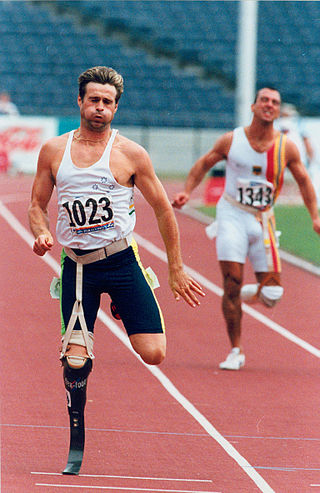
In medicine, a prosthesis, or a prosthetic implant, is an artificial device that replaces a missing body part, which may be lost through trauma, disease, or a condition present at birth. Prostheses are intended to restore the normal functions of the missing body part. Amputee rehabilitation is primarily coordinated by a physiatrist as part of an inter-disciplinary team consisting of physiatrists, prosthetists, nurses, physical therapists, and occupational therapists. Prostheses can be created by hand or with computer-aided design (CAD), a software interface that helps creators design and analyze the creation with computer-generated 2-D and 3-D graphics as well as analysis and optimization tools.
Hemicorporectomy is a radical surgery in which the body below the waist is amputated, transecting the lumbar spine. This removes the legs, the genitalia, urinary system, pelvic bones, anus, and rectum. It is a major procedure recommended only as a last resort for people with severe and potentially fatal illnesses such as osteomyelitis, tumors, severe traumas and intractable decubiti in, or around, the pelvis. By 2009, 66 cases have been reported in medical literature.

A peg leg is a prosthesis, or artificial limb, fitted to the remaining stump of a human leg, especially a wooden one fitted at the knee. Its use dates to antiquity.

Clear Brook High School is a secondary school located in Friendswood, Texas, United States.
James Foort was a Canadian inventor, artist, and innovator in the field of prosthetic limbs.
Therdchai Jivacate is a Thai orthopedic surgeon and inventor known for his humanitarian activities in providing free prosthetic limbs to impoverished amputees, and for his development of techniques allowing low-cost, high-quality prostheses to be made from local materials. The activities of the Prostheses Foundation, which he founded in 1992 under royal sponsorship from the Princess Mother Srinagarindra, have expanded beyond the borders of Thailand to Malaysia, Laos, and Burma. Jivacate has established Thailand's first and only educational institution of occupational therapy at Chiang Mai University. He has also created an educational programme for children suffering from chronic diseases at Maharaj Hospital in Nakhon Ratchasima. In 2008, he was given the Ramon Magsaysay Award for Public Service.
Hanger, Inc. is a leading national provider of products and services that assist in enhancing or restoring the physical capabilities of patients with disabilities or injuries that is headquartered in Austin, Texas. The company provides orthotic and prosthetic (O&P) services, distributes O&P devices and components, manages O&P networks, and provides therapeutic solutions to patients and businesses in acute, post-acute, and clinical settings. Hanger, Inc. operates through two segments: Patient Care and Products & Services.

James Edward Hanger was a Confederate States Army veteran of the American Civil War, a prosthetist and a businessman. It is reported that he became the first amputee of the war after being struck in the leg by a cannonball. Hanger subsequently designed and created his own prosthesis, then went on to found a prosthetic company that continues in business today.
T43 is a disability sport classification for disability athletics, applying to athletes with "Double below knee amputation or similar disability." It includes ISOD classified athletes from the A4 and A9 classes.

T44 is a disability sport classification for disability athletics, applying to "Single below knee amputation or an athlete who can walk with moderately reduced function in one or both legs." It includes ISOD A4 and A9 classes.
Disability sports classification is a system that allows for fair competition between people with different types of disabilities.
A2 is an amputee sport classification used by the International Sports Organization for the Disabled (ISOD).for people with acquired or congenital amputations. A2 sportspeople have one leg amputated above the knee. Their amputations impact their sport performance, including having balance issues, increased energy costs, higher rates of oxygen consumption, and issues with their gait.
A3 is an amputee sport classification used by the International Sports Organization for the Disabled (ISOD) for people with acquired or congenital amputations. A3 classified sportspeople have both legs amputated below knee. Their amputations impact their sport performance, including having balance issues, increased energy costs, higher rates of oxygen consumption, and issues with their gait. Sports people in this class are eligible to participate in include athletics, swimming, sitting volleyball, archery, weightlifting, badminton, lawn bowls, sitzball and wheelchair basketball.
A4 is an amputee sport classification used by the International Sports Organization for the Disabled (ISOD).for people with acquired or congenital amputations. People in this class have one leg amputated below the knee. Their amputations impact their sport performance, including having balance issues, increased energy costs, higher rates of oxygen consumption, and issues with their gait. Sports people in this class are eligible to participate in include athletics, swimming, sitting volleyball, archery, weightlifting, wheelchair basketball, amputee basketball, amputee football, lawn bowls, and sitzball.

Brandon Holiday is a Paracanoe Sprint Kayaker from the United States.
Robert S. Gailey Jr., PT, PhD, FAPTA, is an American physical therapist; professor at the University of Miami Miller School of Medicine Department of Physical Therapy; and the Director of the Neil Spielholz Functional Outcomes Research & Evaluation Center. His research efforts include amputee rehabilitation, prosthetic gait, and functional assessment. He developed the Amputee Mobility Predictor (AMP), an outcome measure designed to evaluate the ambulatory potential of lower-limb amputees with and without the use of a prosthesis. In 2002, he was appointed as a Special Advisor to the United States Department of Defense for amputee rehabilitation. In the aftermath of the 2010 Haiti earthquake, he served as the rehabilitation coordinator for Project Medishare.

Gait deviations are nominally referred to as any variation of standard human gait, typically manifesting as a coping mechanism in response to an anatomical impairment. Lower-limb amputees are unable to maintain the characteristic walking patterns of an able-bodied individual due to the removal of some portion of the impaired leg. Without the anatomical structure and neuromechanical control of the removed leg segment, amputees must use alternative compensatory strategies to walk efficiently. Prosthetic limbs provide support to the user and more advanced models attempt to mimic the function of the missing anatomy, including biomechanically controlled ankle and knee joints. However, amputees still display quantifiable differences in many measures of ambulation when compared to able-bodied individuals. Several common observations are whole-body movements, slower and wider steps, shorter strides, and increased sway.

Adaptive Standing Tennis is a form of tennis for individuals with physical disability who play the sport of tennis standing, or ambulatory as opposed to their counterparts who play wheelchair tennis, playing tennis in a wheelchair.

USA TAP OPEN was the first International Adaptive Standing Tennis tournament to take place in the United States in American history.

An veterinary prosthesis is a medical device that takes the place of an absent body part for an animal. These devices are created with the intention of mimicking the body part to serve the same purpose and functionality. The design of new animal prosthesis is driven by the needs of individual animals in consideration with environmental requirements and attachment sites.















